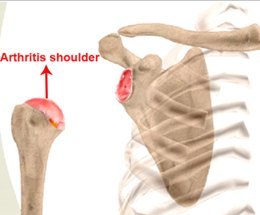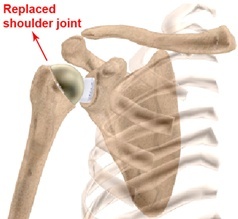Read More
Shoulder Joint Replacement
Shoulder joint replacement is a surgical procedure performed to replace the damaged shoulder joint with the artificial implants.

Indications
Shoulder joint replacement is usually performed when the joint is severely damaged by osteoarthritis, rheumatoid arthritis, post-traumatic arthritis, rotator cuff tear arthropathy, avascular necrosis and failed former shoulder replacement surgery.
Diagnosis
The diagnosis of osteoarthritis is made on history, physical examination & X-rays. There is no blood test to diagnose Osteoarthritis (wear & tear arthritis).
Procedure
During the surgery an incision is made over the affected shoulder to expose the shoulder joint. The humerus is separated from the glenoid socket of the scapula. The arthritic part of the humeral head and the socket is removed and prepared so as to take the artificial components. The glenoid component is then pressed into the socket, and the humeral component is cemented into the upper arm bone. The humeral head component made of metal is then placed on the humeral stem. The artificial components are fixed in place. The joint capsule is stitched together. The muscle and tendons are then repaired and the skin is closed.

Risks and Complications
Possible risks and complications specific to shoulder joint replacement surgery include:
- Infection around an implanted joint
- Dislocation or instability of an implanted joint
- Fracture of the humerus or scapula
- Damage to nerves or blood vessels
- Blood clots (deep vein thrombosis)
- Wound irritation
- Arm length discrepancies
- Wearing of the joints
- Scar formation






